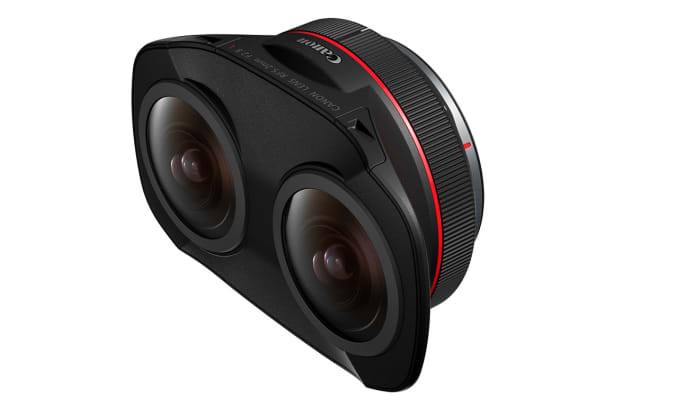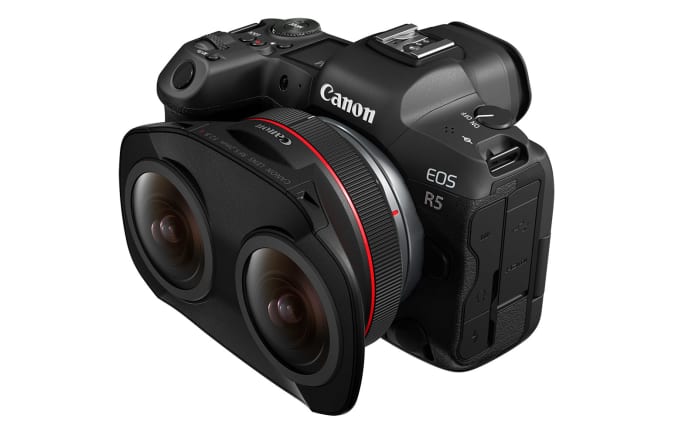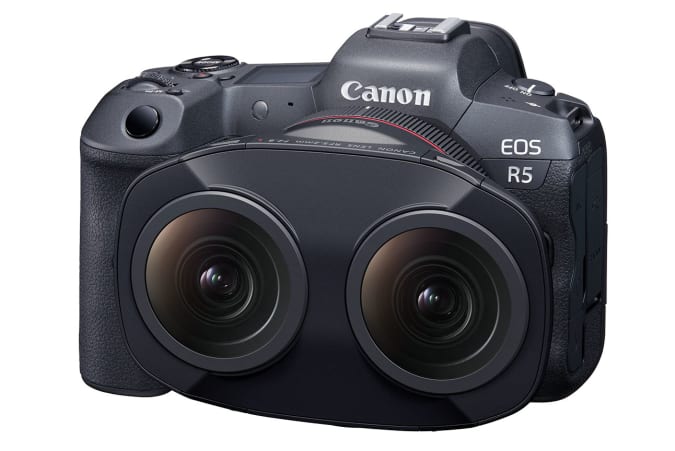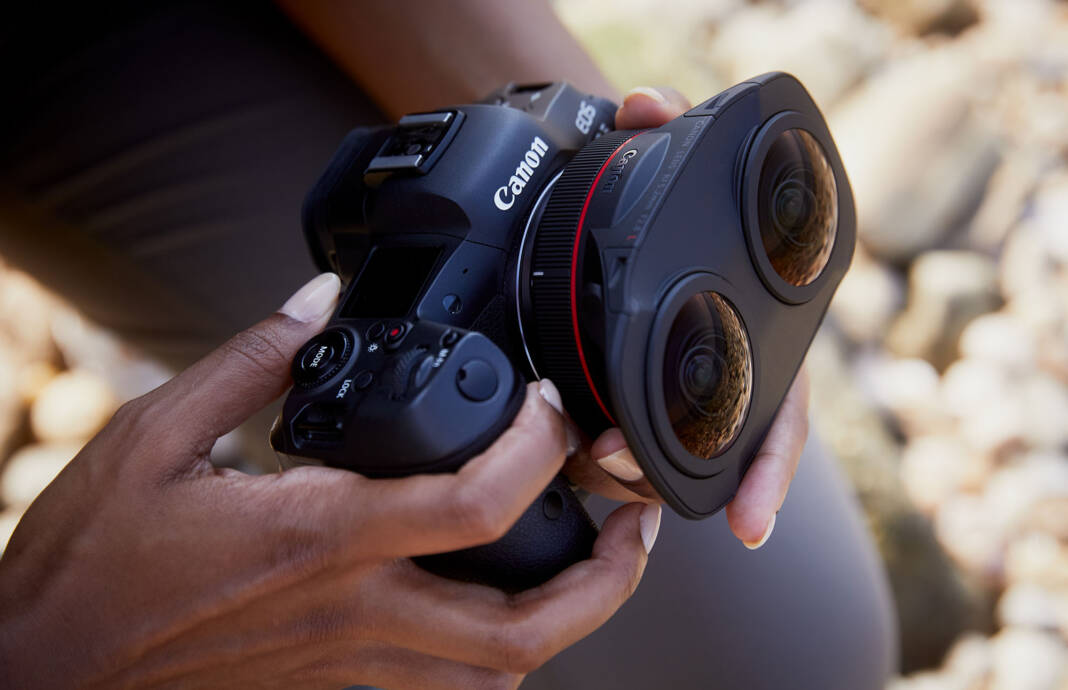Canon has made a surprising product announcement, revealing a dual, RF mount fisheye lens that is segment of an all-unique plan known as EOS VR. Its aim is nothing no longer up to to remodel digital actuality (VR) and augmented actuality (AR) manufacturing by making workflow extra helpful than present VR steal programs, whereas delivering the quality of a corpulent-frame mirrorless digicam.
The major product is the $1,999 RF5.2mm F2.8 L Twin Fisheye handbook lens designed particularly to mount on Canon’s 8K-capable EOS R5 digicam. It be a extremely uncommon attempting product, to claim the least, with two bulging fisheye lenses mounted facet by facet. They’re placed roughly 60mm (2.4 inches) apart to match human interpupillary distance and provide cheerful parallax for VR and AR.

The lens works entirely with Canon’s EOS R5, chosen for its 8K video ability. When shooting, it projects two spherical photos onto the digicam’s 45-megapixel sensor. It helps 190-diploma steal, taking into yarn provide of stereoscopic 180-diploma 3D photos or photos at up to eight,192 x 4,096 (8K) option for AR or VR applications.
The lens has some uncommon parts, like a hoop that focuses both lenses straight away and an Allen screw adjustment that lets in you to tweak the focus of 1 lens to precisely match the more than a few. In any other case, you glean parts generally chanced on in high-end Canon L RF mount glass, like coatings to management flare and ghosting, grime and water resistant sealing and a solid F2.8 to F16 aperture range. Despite the queer looks, the lens is kind of compact and no longer mighty increased than Canon’s 35mm F1.8 lens.

The lens is ideal one segment of the equation, though. Canon is working on a firmware change for the R5 with unique parts to toughen the lens and EOS VR plan. That capabilities MF peaking and handbook focus confirm through Canon’s Twin Pixel autofocus plan, along with a “Magic Window” UI that helps users thought for provide to assorted styles of headsets.
In addition, Canon made its have EOS VR Utility and EOS VR Plugin apps, every on hand by subscription for $5 per month (with a free trial interval). The VR Utility app flips the stereo photos left to correct and converts them from spherical to an “equirectangular” square image that would possibly perhaps well objective additionally be considered on a VR headset. It also affords like a flash modifying tools like trimming of clips and utility of a LUT, whereas letting you commerce to preset resolutions and file forms (DPX, Professional Res, H264, and heaps others.) earlier than export.
There is also the EOS VR trail-in for Adobe Premiere that “will convert the dual fisheye imagery to equirectangular, whereas allowing the ability to diminish, shade, and edit with the corpulent management of Premiere Professional,” Canon told Engadget. It also capacity that you can export photos to the specified spec for assorted styles of provide.
On high of these apps, you would make use of the present Digicam Join app and Canon’s EOS Utility to management steal. Both will most likely be up so some distance down the freeway to provide “remote management are residing witness functionality for monitoring functions whereas on-the-saunter,” Canon acknowledged in a press release.
The plan would possibly perhaps well objective additionally be venerable for weddings, journalism, sports activities, coaching, events and extra, whereas offering a preference of benefits over present VR cameras. To delivery with, it be designed to bring better quality than standalone VR cameras with smaller lenses and sensors like the $5,000 Insta360 Professional 2. At the identical time, you glean the total R5’s tools like log shooting, RAW steal, 10-bit video and extra. And in case you would possibly perhaps no longer the use of the VR lens, the R5 would possibly perhaps well objective additionally be venerable for traditional video manufacturing or photo shoots, unlike dedicated VR cameras.

At the identical, the manufacturing route of is extra helpful and more cost effective than with dual cameras venerable in increased-end productions. These cameras ought to be rigged, synced, centered and positioned properly, with the final result being two recordsdata in plenty of conditions. Canon’s EOS VR plan, by distinction, delivers identical quality nonetheless affords focus and setup like a conventional digicam, whereas leaving you with a single file to edit on the end.
The total plan is no longer genuinely exactly cheap, pondering about it be critical to pay $1,999 for the lens and $3,899 in case you possess no longer got already bought an R5 digicam, for a whole of $5,898. On the opposite hand, pondering about how enviornment of interest and peculiar the lens is, it charges no longer up to I expected. There is also the pickle of R5 overheating that limits 8K recording times to 20 minutes, with a 10-minute recovery interval. It’s most likely you’ll be ready to enhance that by capturing 8K to an exterior Ninja V+ RAW recorder, nonetheless that’ll add $1,500 to your value.
Nonetheless, it looks very promising for VR manufacturing, which has boomed in popularity throughout the COVID-19 pandemic (though mute is no longer genuinely exactly mainstream). It be been in particular in-ask for commercial coaching and collaboration, a doubtlessly wealthy vein for video producers. A vogue of these of us, in particular if they possess already bought a Canon EOS R5, is probably arresting to leap into VR work if Canon’s unique plan is as easy to make use of because it promises. The lens and EOS VR plan are residing to come in gradual December 2021.

